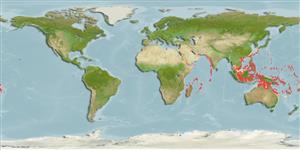Environment: milieu / climate zone / rango de profundidad / distribution range
Ecología
marino asociado a arrecife; rango de profundidad 8 - 55 m (Ref. 10671). Tropical
Indo-West Pacific: Mozambique to the Philippines.
Tamaño / Peso / Age
Madurez: Lm ? range ? - ? cm
Max length : 30.0 cm SL macho / no sexado; (Ref. 48637)
Espinas dorsales (total) : 5; Radios blandos dorsales (total) : 28 - 30; Espinas anales: 2; Radios blandos anales: 28. Fresh specimens with yellow caudal fin and blackish peduncular plate; preserved specimens uniform grey in color and dark fins (pectorals pale). Oblique groove on side of snout below nostrils, its length about equal to length of naked area enclosing nostrils (Ref 9808).
Body shape (shape guide): fusiform / normal; Cross section: compressed.
Inhabits coastal to outer reef slopes, usually swimming along upper edges of drop-offs in small schools (Ref. 48637). Descends from the water column to the reef front to be cleaned by Labroides dimidiatus (Ref. 4974). Feeds on benthic algae (Ref. 3145). Forms aggregations, feeding on zooplankton well above the bottom over or in the immediate vicinity of reefs. Males exhibit rapid and striking changes in color pattern during courtship (Ref. 10671).
Life cycle and mating behavior
Madurez | Reproducción | Puesta | Huevos | Fecundidad | Larva
Randall, J.E., 1994. Unicornfishes of the subgenus Axinurus Perciformes: Acanthuridae: Naso), with description of a new species. Copeia 1994(1):116-124. (Ref. 10671)
IUCN Red List Status (Ref. 130435: Version 2024-2)
Threat to humans
Harmless
Human uses
Herramientas
Special reports
Download XML
Fuentes de Internet
Estimates based on models
Preferred temperature (Referencia
123201): 25.2 - 28.9, mean 27.6 °C (based on 388 cells).
Phylogenetic diversity index (Referencia
82804): PD
50 = 0.5000 [Uniqueness, from 0.5 = low to 2.0 = high].
Bayesian length-weight: a=0.02042 (0.01183 - 0.03525), b=3.02 (2.87 - 3.17), in cm total length, based on LWR estimates for this species & Genus-body shape (Ref.
93245).
Nivel trófico (Referencia
69278): 2.6 ±0.29 se; based on food items.
Resiliencia (Referencia
120179): Medio, población duplicada en un tiempo mínimo de 1.4-4.4 años (Preliminary K or Fecundity.).
Fishing Vulnerability (Ref.
59153): Low to moderate vulnerability (27 of 100).
🛈
Nutrients (Ref.
124155): Calcium = 51.2 [31.1, 91.2] mg/100g; Iron = 0.606 [0.315, 1.012] mg/100g; Protein = 18.8 [17.7, 19.7] %; Omega3 = 0.145 [0.097, 0.256] g/100g; Selenium = 31.6 [17.9, 52.1] μg/100g; VitaminA = 74.4 [27.9, 200.8] μg/100g; Zinc = 1.5 [1.1, 2.1] mg/100g (wet weight);
